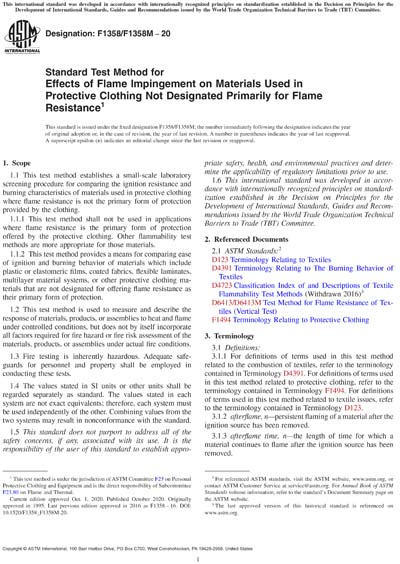Most recent
ASTM F1358/F1358M-20
Standard Test Method for Effects of Flame Impingement on Materials Used in Protective Clothing Not Designated Primarily for Flame Resistance
1.1 This test method establishes a small-scale laboratory screening procedure for comparing the ignition resistance and burning characteristics of materials used in protective clothing where flame resistance is not the primary form of protection provided by the clothing.
1.1.1 This test method shall not be used in applications where flame resistance is the primary form of protection offered by the protective clothing. Other flammability test methods are more appropriate for those materials.
1.1.2 This test method provides a means for comparing ease of ignition and burning behavior of materials which include plastic or elastomeric films, coated fabrics, flexible laminates, multilayer material systems, or other protective clothing materials that are not designated for offering flame resistance as their primary form of protection.
1.2 This test method is used to measure and describe the response of materials, products, or assemblies to heat and flame under controlled conditions, but does not by itself incorporate all factors required for fire hazard or fire risk assessment of the materials, products, or assemblies under actual fire conditions.
1.3 Fire testing is inherently hazardous. Adequate safeguards for personnel and property shall be employed in conducting these tests.
1.4 The values stated in SI units or other units shall be regarded separately as standard. The values stated in each system are not exact equivalents; therefore, each system must be used independently of the other. Combining values from the two systems may result in nonconformance with the standard.
1.5 This standard does not purport to address all of the safety concerns, if any, associated with its use. It is the responsibility of the user of this standard to establish appropriate safety, health, and environmental practices and determine the applicability of regulatory limitations prior to use.
1.6 This international standard was developed in accordance with internationally recognized principles on standardization established in the Decision on Principles for the Development of International Standards, Guides and Recommendations issued by the World Trade Organization Technical Barriers to Trade (TBT) Committee.
Content Provider
ASTM International [astm]






